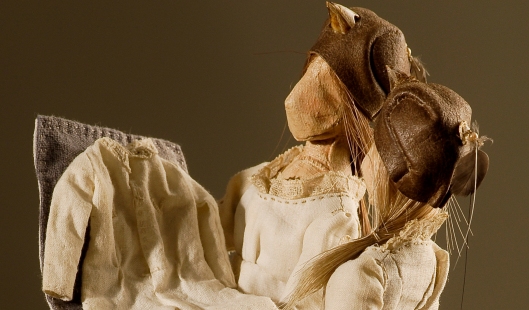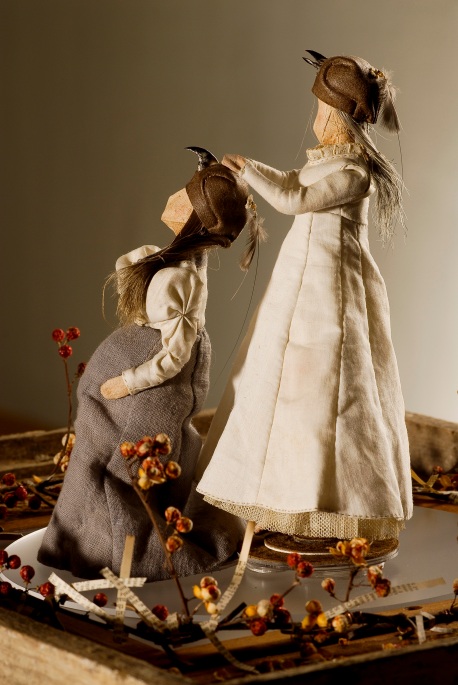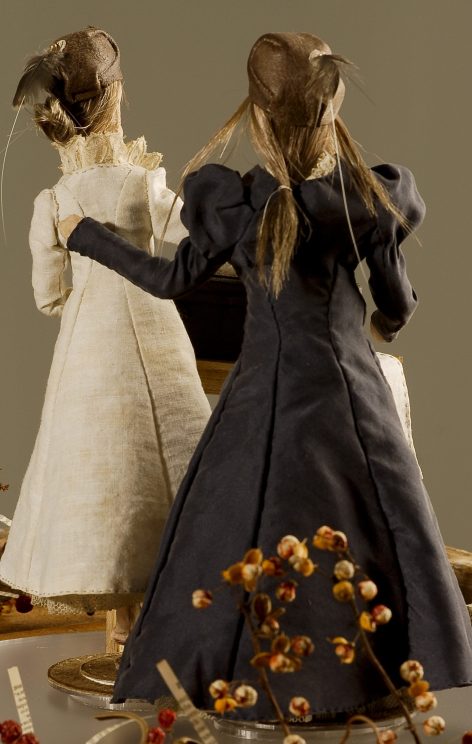 History offers few instances of women helping create scripture. Hinduism’s sacred Rigveda may have been partly composed by women, and scholars believe the biblical Book of Ruth was possibly written by a woman, but the evidence for each is wanting. And while Muhammad’s widow was entrusted with the manuscript that would become the Quran, its scribe was a man named Zayd ibn Thabit. The only clear exception to this is the Book of Mormon, which Joseph Smith partially dictated to his wife Emma. The central role of Mormon women in the church was therefore fixed from the start.
History offers few instances of women helping create scripture. Hinduism’s sacred Rigveda may have been partly composed by women, and scholars believe the biblical Book of Ruth was possibly written by a woman, but the evidence for each is wanting. And while Muhammad’s widow was entrusted with the manuscript that would become the Quran, its scribe was a man named Zayd ibn Thabit. The only clear exception to this is the Book of Mormon, which Joseph Smith partially dictated to his wife Emma. The central role of Mormon women in the church was therefore fixed from the start.
In 1842 Joseph Smith organized the church sisters into a philanthropic organization known as the Relief Society. Among other things, the Relief Society sent women to medical school and opened cooperative stores. Operating independently from local bishops, it afforded Mormon women unprecedented independence. In fact the early Mormon Church was a feminist pathfinder. The first Mormon pioneers arrived in Salt Lake City in 1846, and by 1870 Utah Territory became the second place in the Union (after Wyoming) to give women the right to vote—nearly fifty years before the Nineteenth Amendment. But Mormons wanted freedom for all women, and that same year the Relief Society held a meeting in which the renowned poet Eliza Snow entrusted Bathsheba Smith with a mission to travel “all through the South” preaching “retrenchment [restriction of government spending] … and women’s rights.”

In 1872 the Relief Society formed its own publication, Woman’s Exponent, a strident voice for women’s suffrage. But Mormon feminism was by no means restricted to the vote. Brigham Young himself once wrote, “we have sisters here who, if they had the privilege of studying, would make just as good mathematicians or accountants as any man; and we think they ought to have the privilege…” Neither were Mormon feminist legal efforts restricted to enfranchisement. Utah then had some of the most liberal divorce laws in the nation as well as a higher percentage of female doctors and midwives than any other U.S. state or territory.
As Mormon women were empowered, they also pursued their faith more fully. As a result, they soon outperformed men in nearly every area of church activity. In 1906 Elder J. Golden Kimball noted that the Priesthood quorums had “become lax in their work,” while women’s groups had “taken the right of way.” The General Priesthood Committee was therefore conceived in 1908 to bolster male involvement.
During and after World War I, Mormon feminists focused on helping their communities through social projects such as the Relief Society Social Services and the Primary Children’s Hospital. Meanwhile, thanks to the General Priesthood Committee, male authority began to eclipse female independence within the church. By the 1930s, female ordinance work was forbidden and the Mormon community was divided into feminists and those who felt women should primarily be mothers.
The emergence of radical feminism in the 1960s triggered a counter-reaction among the Priesthood Correlation Program; in 1970 the Relief Society magazine was discontinued and in 1974 all Relief Society funds and operations were brought under the control of male leaders. Yet the 1970s also saw a renaissance of Mormon liberal feminism, with the journals Exponent II, Dialogue and Sunstone featuring penetrating feminist thought, and the Alice Louise Reynolds Forum in Provo, Utah providing a place for women to explore those thoughts. Also, in 1978 Elder Dallin H. Oaks, then President of Brigham Young University, and his assistant Dr. Marilyn Arnold, established the Women’s Research Institute (WRI).
However, since then, the church has asserted its opposition to feminism. In 1979 the church excommunicated Sonia Johnson, an outspoken supporter of the Equal Rights Amendment (ERA), which proposed to guarantee equal rights for women. In 1993 Mormon feminist Janice Allred was excommunicated for supporting female ordination. In 1995 Mormon feminists Lynn Whitesides, Maxine Hanks and Lavina Anderson were excommunicated, followed by Margaret Toscano in 2000. In 2009 the WRI was shut down. And in 2014 Kate Kelly, who founded Ordain Women, a group that supports female ordination, was excommunicated. “Paradoxically,” notes artist Page Turner, “as feminism has been suppressed in the church, it has grown and evolved in the larger Mormon culture.” She added that these days, the Relief Society cannot hold a meeting of any kind without a male priest in the room to approve of everything they do.
The story of the Mormon struggle to liberate women, and subsequent reaction against that liberation, is beautifully told in Turner’s latest work, a collection of tableaux entitled ‘Power and Restraint: a Feminist Perspective on Mormon Sisterhood’. Each piece comprises a beehive super (a symbol of the faith) bedded with bittersweet sprigs and backed with white fabric (symbolizing the temple veil) taken from an ancient temple wedding gown once worn to the Salt Lake Temple.

The scenes depict Mormon women in various settings: one displays her holy temple garments, another blesses her pregnant sister (a practice women may no longer perform). This is something of a departure for Turner, whose past work is often mischievously surreal. For example, a bird skeleton, for instance, finely sewn into the plush folds of a Victorian dress, offers us material exuberance paired with a wry memento mori. Such fragments are almost philosophical epigrams. But if her previous work is epigrammatic, her commentary on Mormon sisterhood is fully argumentative.




Content doesn’t outpace form, however, and while the elegance of execution here makes it all seem effortless, don’t be fooled—it’s not. Its visual appeal makes this a work of instant gratification, but its detail and meaning make it one that equally rewards patience and attention. Indeed, everything from the falcon hoods fashioned from a child’s coat to the dolls’ stuffing is as vibrant and suffused with history as the story they’ve been assembled to tell.

All images copyright Page Turner, photo credit: Sean Cuddy
David Volodzko is a former university lecturer and a writer whose interests include religious history, feminism and art. He blogs at Rational Consent and tweets @DavidVolodzko. Some articles of interest include: China’s Attack on Feminism? Not Quite., Feminism With Chinese Characteristics, Gender Equality in South Korea: A Long Way to Go
 Page Turner, Roanoke artist, collects items of deep personal meaning to painstakingly create delicate objects that honor the feminine, and the desires, experiences, and roles of women. Raised as a devout Mormon, she looks to the Church and its complex history as inspiration. Her works are informed by the traditional hand-working skills that have been passed down through the generations. In this body of work, Turner explores the divide between righteousness within the faith and women’s personal power; with deep reverence, she pays homage to the original pioneer women of the Mormon Church, as well as the contemporary sisterhood.
Page Turner, Roanoke artist, collects items of deep personal meaning to painstakingly create delicate objects that honor the feminine, and the desires, experiences, and roles of women. Raised as a devout Mormon, she looks to the Church and its complex history as inspiration. Her works are informed by the traditional hand-working skills that have been passed down through the generations. In this body of work, Turner explores the divide between righteousness within the faith and women’s personal power; with deep reverence, she pays homage to the original pioneer women of the Mormon Church, as well as the contemporary sisterhood.
Turner’s Power & Restraint: a Feminist Perspective on Mormon Sisterhood was commissioned and exhibited in the Eleanor D. Wilson Museum at Hollins University in Roanoke, Virginia.
Turner has exhibited widely in Virginia, in North Carolina, in Washington, DC, and in Los Angeles. She was the cover artist for Exponent II- Publishing the Experiences of Mormon Women since 1974, cover artist for Dialogue: A Journal of Mormon Thought, Artemis Journal: Artist and Writers of the Blue Ridge, and has been featured in six issues of Studio Visit Magazine, blogs and other media.


Is there meaning intended in the fact that the women figures have no faces, no eyes to see, and no mouths to speak?
LikeLike
Carol, I appreciate your thoughtful observations. The short answer is, Yes! It does illustrate their blindness and silence. In the early history of the Mormon Church, women were equal in their participation in the faith and culture. With more opportunity than women outside the faith at the time. A stark contrast to the culture and religious practices of women today in the Mormon church.
LikeLike
Carol, I was going to ask the same question as I read this interesting blog. You beat me to it. David or Page, can you please tell us more about these faceless figures?
The craftsman[sic.]ship is lovely. I’m sure the symbolism is useful. Why was Mormon feminism suppressed? Do ordinary people get to see these sculptures? Are they displayed in temples and holy places?
LikeLike
This sentence, “The central role of Mormon women in the church was therefore fixed from the start,” was written to demonstrate Mormonism’s inclusion of a woman participating (as a scribe) in the writing of The Book of Mormon, therefore, showing, according to the article, that Mormonism is an “exception” from other major world religions. The article does go on to say that after World War I “male authority began to eclipse female independence within the church. By the 1930s, female ordinance work was forbidden….” I think this pattern is evident within most (if not all) major religious traditions–initial female empowerment followed fairly soon (chronology-wise) by male authority curtailing the activities of women. Women in Christianity and Islam (the traditions I’m more familiar with) were assumed to be (and were) leaders within their respective traditions. Today, the struggle continues for women to re-take their place “at the table.”
The images (sculptures) are lovely. I too wondered why the women are faceless.
LikeLike
How true!! It even extends to so-called liberal traditions, e.g. Unitarian Universalist. Men where I attend think they are above and beyond any sort of male chauvinism. However, whenever a woman behaves in certain ways, comments are made–not publicly of course, but the word does get around.
LikeLike
As someone who was born and raised in Ogden, Utah, my assigned identity was “non-Mormon.” This was despite my mother and her mother being direct descendants of Martin Harris – a founder of the church. I have had a unique vantage point as similtaneously an insider, outsider, and as a woman. The facelessness is an accurate portrayal of the experience of being a woman in the church. Unlike patriarchally influenced or co-opted doctrine, such as in Catholicism or Christianity in general, the Mormon church was constructed as a patriarchal institution. From the subjugation of women in polygamy, to the lack of women in any sort of leadership roles, women are the vessels in which “spirit children” are reborn in physical form. The Relief Society was/is a reinforcement of engendered essentialism, i.e., cooking, cleaning, etc. But look, I don’t have any qualms about people finding a spiritual path if it works. I will speak up when I witness the mantel of feminism being applied to a wholly anti-feminist, anti-women institution. Women have always created relational networks – “sisterhoods” – despite patriarchal oppression. That is at the very foundation of women’s lived experience. I am glad Mormon women are no different, but that cannot be equated with feminist liberation.
LikeLike
Thanks, INkwell, for fully explicating a white-washed version of Mormonism.
LikeLike
Thanks David. My favorite picture of the Page Turner dolls is that last one, viewed from the back, just that one hand of the woman so gently supporting her friend, an image that does seem to reflect the solidarity of true “sisterhood.” It’s not unusual in fashion design to use faceless mannequins, that is, not just a young or beautiful person, but how anybody might look in the clothing.
LikeLike
I really like Page Turner’s dolls, and your information about Mormons and feminism, David. What is the significance of the falcon hoods?
LikeLike
One critique of the article: a male priest is *not* required to attend Relief Society meetings. I did appreciate the brief history lesson about women’s roles in the early Church. While I am not behind female ordination, I do consider myself a feminist and am delighted at visible and non-visible ways that women and re-claiming their roles in Church and public life.
LikeLike